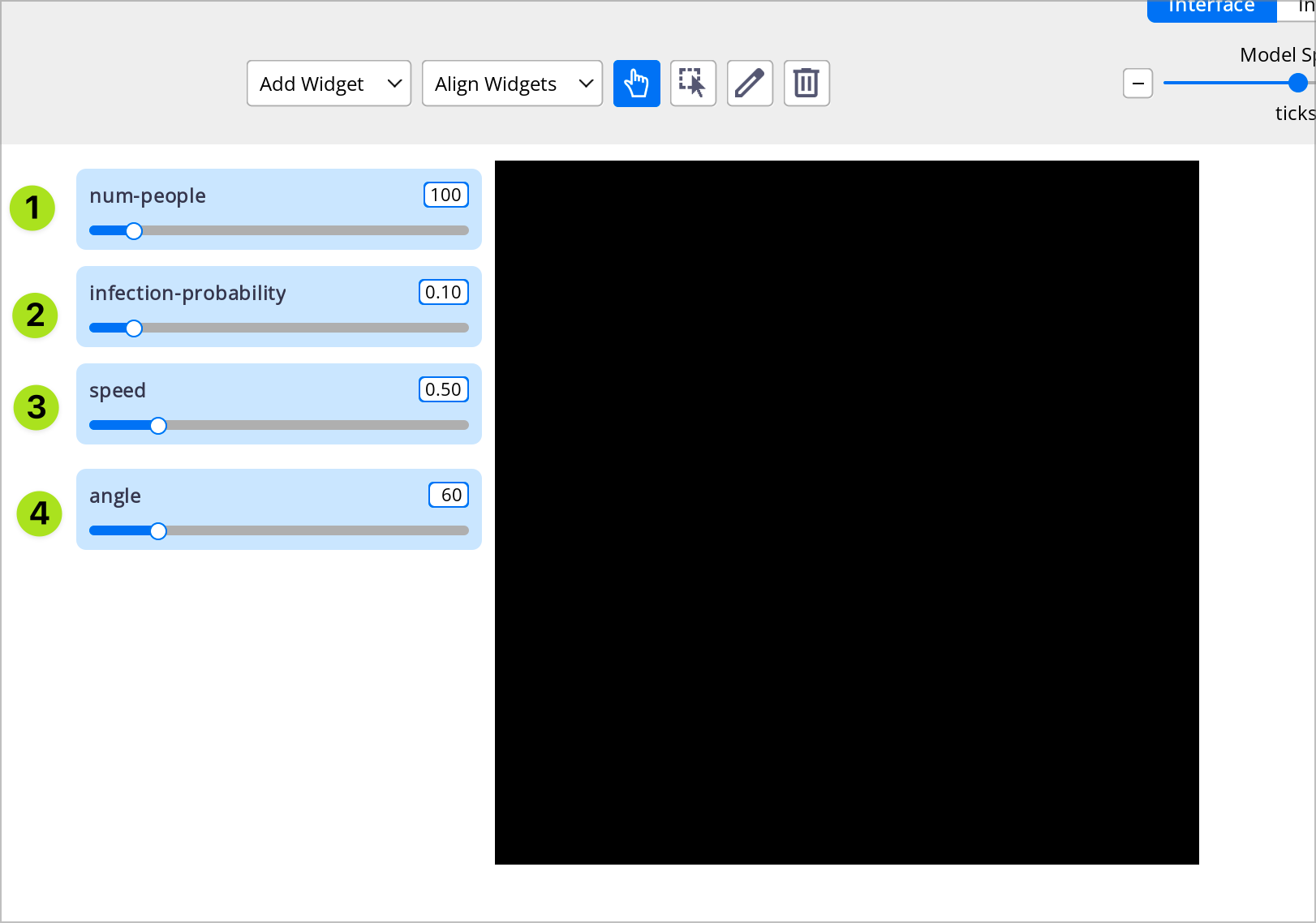In this first model, our agents will have one property accounting for their infection status. They can be either susceptible (S) or infected (I). At each time step, each susceptible agent has a probability of becoming infected, defined by the slider infection-probability. Once infected, agents remain infected for the duration of the simulation.
Characteristics of the agents¶
The agents will be moving randomly around the grid at a constant speed defined by the slider speed. At each time step, they will move to a random place based on their heading and speed. The heading is a random number, and the maximum angle change is defined by the slider angle.
For that reason, I will create the sliders for our simulation as our first step:

Figure 1:Sliders for the spontaneous contagion model.
Remember that all these sliders are global variables, and you can access them from anywhere in your code. You can use them to define agent properties, behaviors, or environmental factors.
Now, let’s create the agents. I want to use a new breed to make sure it reflects better the context of the model. The breed will be called people. Later, we will use the create-people command to create a number of agents defined by the slider num-people. Each agent will be represented as a turtle in NetLogo, and we will set their initial properties and behaviors.
breed [people person] ; Define a new breed called 'people'
people-own [infected?] ; Each person has an 'infected?' propertyFor this model, I will use circles to represent the agents. Susceptible agents will be green, and infected agents will be red. You can use the set color command to change the color of the agents based on their infection status.
Infection dynamics¶
Also, we need to start the simulation with some initial infected agents. We can use a new slider initial-infected to define how many agents will start as infected. We will randomly select that number of agents and set their infected? property to true.
to setup-infected
if initial-infected > num-people [
set initial-infected 1
]
if initial-infected < 1 [
set initial-infected 1
]
ask n-of initial-infected people [
set infected? true
set color red
]
endThe code above will be used to set the initial infected agents. It checks if the number of initial infected agents is valid (not more than the total number of agents and at least one). Then, it randomly selects that number of agents and sets their infected? property to true and changes their color to red. It will be used in the setup procedure.
We also need a method to infect susceptible agents. We can create a procedure called infect that will be called at each time step. This procedure will check if an agent is susceptible and, if so, will generate a random number between 0 and 1. If this number is less than the infection-probability, the agent will become infected.
to infect
ask people with [not infected?] [
if random-float 1 < infection-probability [
set infected? true
set color red
]
]
endThe code above will be used to infect susceptible agents. It checks if an agent is not infected and generates a random number between 0 and 1. If this number is less than the infection-probability, the agent becomes infected, and its color changes to red. It will be called in the go procedure.
Agent movement¶
Finally, we need to implement the movement of the agents. We can create a procedure called move that will be called at each time step. This procedure will update the position of each agent based on its heading and speed.
to move
ask people [
right random angle
left random angle
forward speed
]
endThe code above will be used to move the agents. It updates the heading of each agent by a random angle and moves it forward by the distance defined by the speed slider. It will be called in the go procedure.
Putting it all together¶
Now, we can put everything together in the setup and go procedures. The setup procedure will initialize the simulation, create the agents, set their initial properties, and call the setup-infected procedure. The go procedure will be called at each time step and will call the move and infect procedures.
to setup
clear-all
create-people num-people [
set shape "circle"
set size 1.5
set color green
set infected? false
setxy random-xcor random-ycor
]
setup-infected
reset-ticks
endThe setup procedure initializes the simulation by clearing the environment, creating the agents, setting their initial properties (shape, size, color, infection status, and position), and calling the setup-infected procedure to set the initial infected agents. It also resets the timer to track the simulation time.
to go
move
infect
tick
endThe go procedure is called at each time step and calls the move and infect procedures to update the position of the agents and infect susceptible agents. It also increments the simulation time by one tick.